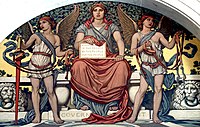
Photo from wikipedia
Consumers regularly have to choose between a pay-per-use and a flat-rate option. Due to the increasing number and range of (digital) services, the frequency at which consumers have to make… Click to show full abstract
Consumers regularly have to choose between a pay-per-use and a flat-rate option. Due to the increasing number and range of (digital) services, the frequency at which consumers have to make tariff-choice decisions to use these services has become even more prevalent. Prior work has demonstrated that consumers’ tariff choices are often systematically biased and identified overconfidence as one of the key drivers. Yet, prior research is non-experimental and focused on the so-called flat-rate bias. By contrast, we examine the effects of overconfidence on the choice between a pay-per-use and a flat-rate option using an experimental approach. We develop an incentive-compatible experiment to provide causal evidence for the effect of overconfidence on tariff-choice decisions. We find that overconfident (underconfident) consumers underestimate (overestimate) their actual usage, which leads them to choose a pay-per-use (flat-rate) option relatively more frequently. Based on the results, we discuss theoretical and managerial implications as well as avenues for future research.
Journal Title: Review of Managerial Science
Year Published: 2020
Link to full text (if available)
Share on Social Media: Sign Up to like & get
recommendations!